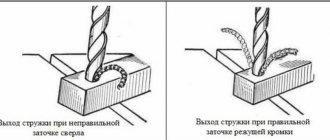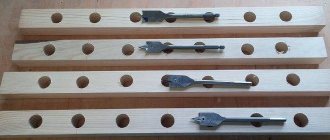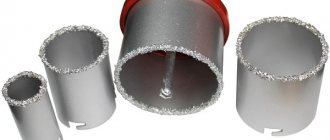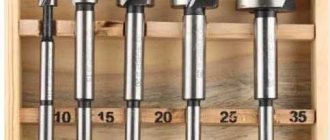Granite stone is a material that is very difficult to process. It is hard and fragile at the same time, which requires a special approach to it. Therefore, if you are planning to work with this stone, it is important to choose the right drill bit for granite, as well as know how to drill through granite correctly so as not to damage or split it during the process.
Basic rules for drilling granite stone
It should be borne in mind that drilling holes in granite is always carried out only at a low speed of the tool - usually it is the first or second speed, but no more.
In this case, the use of drills should be with variable speed, which directly depends on the diameter:
- if you use a 6 mm diameter drill, the number of revolutions per minute will be 2000 ;
- if the granite drill has a diameter of 12 mm , then the speed mode is set to 950 revolutions;
- if the diameter is 20 mm , the speed should be 700 revolutions.
So, the larger the diameter of the tubular drill (bit) for granite, the lower the speed of revolutions per minute.
Drilling granite must be carried out with the obligatory use of water to cool the cutting parts of the drill. Water also washes away unnecessary sludge. It also cools the slabs themselves, helping to ensure clean, neat holes. In professional production, water supply during such work is carried out under automatic pressure so that the granite drill is constantly washed and cooled. Using water will not only help carry out all the work as carefully as possible, but will also extend the life of any drill.
If you are a beginner and are faced with how to properly drill a hole for the first time, it would be best to first practice by taking some unnecessary or defective small granite slab.
Do not mark with a simple pencil directly on the material: since you will be dealing with a polished slab, it simply will not leave any mark on it. You can make pencil marks on porcelain tiles, but not on natural granite slabs. It’s better to first stick on a strip of masking tape and mark the drilling location on it.
Read also: How to remove a TV from a wall bracket
There are two methods on how to drill granite:
- Position the drill at a slight angle and drill a test slot first. Then, using smooth movements, align the crown to a position perpendicular to the slab. If you do not adhere to this subtlety, the drill will dangle along the polished stone without going deep.
- The second method is also related to this feature of the stone. If the centering of the drill is inaccurate, and the novice master has not yet acquired a certain skill, the polished surface of granite is very easy to scratch. It's best to use a scrap piece first and try to drill a test hole in the granite. If it turns out well, use it as a sample or template for subsequent ones. To work "from a template", place it on the area of granite that you plan to drill "cleanly" and fix it. The drill definitely won’t move around the polishing, and water can be supplied into this hole.
Is a pobedite tool used for drilling granite?
You can drill or drill into granite using a pobedite tool, but there is a high probability that the drill will not withstand the load placed on it. That is why, when choosing what to drill a stone product with, it is better to give preference to other types of tools. If you still haven’t found anything else to drill granite with and have chosen a pobedite tool, you should not use it in hammer drill mode.
When drilling, carefully monitor its effectiveness. If it has noticeably decreased, then you should stop processing and sharpen the drill, for which you can use a semicircular needle file. A pobedit tool used as a drill for working with granite will have to be sharpened quite often: once every 60 seconds.
What you will need
When asked how to drill granite, many say that this will require some complex specialized tool, but this is not so. A regular electric drill is suitable for the job; it is only important that it has the option of adjusting the speed of revolutions per minute.
In addition to the drill, you will also need:
- a diamond-coated drill having the required diameter;
- plain water.
First of all, you need to fix the granite slab as carefully as possible, making sure that the surface on which it is installed is as flat as possible. Before starting work, you should use a drill to mark the center of the future hole: this will help prevent the tool from sliding along the polishing surface. Install a diamond-coated bit into the drill (remember that using a non-coated bit will not allow you to make a hole).
Drilling should be carried out exclusively at low tool speed without using the punching option. When you turn on the perforation mode, the granite may crack. Regularly rinse the stone and drill with water: as already mentioned, this helps to cool, clean, and neaten the hole itself. In order to add water, you can invite an assistant. Or fill a plastic bottle with water, make a hole in the lid and use such a “sprinkler” to water the drill and hole yourself.
What to do if there is no diamond crown
If you don’t have a diamond bit and you don’t know how to drill granite in this situation, you can carefully stick a plasticine ring 3-5 mm high around the entire circumference of the future hole. Place a little corundum, pobedite powder or diamond dust inside the ring and add water. Attach a copper tube to the drill (you can use a tube from any other non-ferrous metal). Now you can drill granite - also at low tool speeds, without using a hammer drill. You will certainly need water here: first of all, in order to regularly cool the metal tube.
If there is neither a crown nor a tube, what to do?
In this case, craftsmen suggest using an emergency and risky drilling method - using a Pobedit drill, at high speed with a constant supply of water. During this process, you will need to constantly sharpen the drill because it will stop from time to time. Sharpen the drill with a semicircular file, very carefully, without overheating its teeth. Otherwise, the drill will soften and become dull even faster.
Helpful advice: if you are processing granite with a pobedite drill, it should be sharpened at least every 20-40 seconds of work.
Drilling on granite is a very difficult and painstaking job. It requires certain knowledge and skills. But if you wish, you can always purchase them by seeking advice from more experienced craftsmen. In order to practice, first use fragments of stone: this will help both “get your hands on” and prevent damage to a high-quality new workpiece.
If there is no diamond tool
In addition to diamond cutting tools, pobedit drills, diamond dust or corundum can be used to make holes. These methods are less effective and take longer, but still allow you to achieve the desired result.
Drilling holes in granite using a Pobedit drill is performed at high rotation speed and a constant supply of water. If the process begins to slow down, the drill must be removed and sharpened.
To make a hole in granite using corundum, diamond dust or ground pobedite, you will need a copper or brass tube, which will need to be fixed in a drill. On the granite surface, around the diameter of the marked hole, make a rim of plasticine or quick-drying putty 4-5 mm high.
Pour abrasive material inside the fence and drill with a tube at the lowest possible speed of the drill. During operation, do not forget to periodically add water for cooling.
How to drill granite
Natural granite is one of the most popular materials for making countertops, sinks, cladding, and decorative items. High strength characteristics allow it to be used almost everywhere. The stone is not afraid of impacts, water, temperature changes, and can serve without damage for centuries. A granite product can be damaged only due to one’s own carelessness, as well as if the installation technology is not followed. Considering that the mineral is quite difficult to process, products from it are manufactured only in factory conditions. Particular care must be taken when drilling holes in stone blanks.
Drilling technology
The work is carried out in several stages:
- The workpiece or granite slab is laid on a reliable, durable, stable base. The part must be supported at every point; no edge can hang over the workbench. Unevenness on the base is not allowed.
- Using a stone or metal drill, mark the location of the hole. The risk is also necessary for fixing the working part of the machine. This will prevent the drill from sliding on the glossy surface.
- Place diamond-coated crowns on the tool and begin drilling. If the workpiece is small in thickness, you can use a conventional drill with the ability to adjust the speed. If you don’t have a diamond drill in the house, you can use any other one, but first you need to stick a piece of plasticine in the shape of a ball with a small depression at the location of the hole. Corundum or diamond dust is poured into this hole. After this, you can start drilling with a regular drill, and the added minerals will provide additional abrasive action.
Read also: Copper ore deposits in Russia on the map
Important: During operation, large amounts of stone dust may be generated. It settles on the mucous membranes of the respiratory tract and eyes, causing irritation. When drilling, personal protective equipment must be used. Also, during the process, the working area must be irrigated with water. On factory machines this happens automatically, but in a home workshop you will have to involve a second person. Water is needed to cool and bind the stone dust. For irrigation, you can use a regular plastic bottle with a hole in the lid.
Features of drilling granite
What is needed for drilling stone (including granite)? Let us consider the stages of the procedure and preparation for it in more detail.
Preparation of the workplace
The working surface on which the stone element will be laid for processing must not only be strong and reliable, but also completely flat, and its dimensions must not be less than the dimensions of the product being processed. It is very important that no part of the latter remains suspended.
Special tool with built-in coolant supply – a professional approach to drilling natural stone
Tools and Supplies
To successfully drill granite, you need to prepare the following tools and consumables:
- electric drill;
- a drill bit of the required diameter, the working part of which is coated with diamond;
- water.
Diamond coated tubular drill bits for drilling granite and other stones
To ensure that the diamond drill, which will be used to form a hole in granite, does not slide off the smooth surface, you must first make a recess at the processing site. For this purpose, you can use a regular metal drill.
Why is water needed?
When wondering how to drill through granite, you should keep in mind that performing such a procedure without using water as a coolant is not easy. Cooling of the granite drill during operation is mandatory; it is for this purpose that water must be supplied to the processing area.
Device for supplying water to the drilling area
The simplest device for cooling a drill for stone can be made from a plastic bottle by making several small holes in its lid. You will receive a kind of spray bottle, which is very convenient to use during processing. It should be borne in mind that when drilling, water should always be at hand in order to be able to cool the heated drill at any time.
Having selected a diamond drill according to the required diameter, which is optimally suited for drilling stone (including something as hard as granite), the tool must be fixed in the chuck of an electric drill. After this, you can begin to form a hole in the workpiece.
An alternative to water cooling is a bit with a greasy lubricant inside, which flows out into the drilling area when heated
How is drilling done?
How to drill a stone so as not to split it, but to form a high-quality hole in it? This question is asked by those who have never encountered the procedure before and are planning to do it themselves. In such cases, you should always remember that the tool you are using cannot be set to hammer mode, since the created shock load can cause the workpiece to split.
Making holes in stone (including drilling marble) should begin at low speeds of the tool, positioning it at a significant angle. After a small groove has been formed on the surface to be treated, the position of the drill can be gradually leveled.
The pressure of the drill on the stone during processing should be light, and care must be taken that the cutting tool does not damage the polished surface of the product. Do not forget that water must be constantly supplied to the drilled area of the hole in which the drill continues to work. Very often, to fulfill such an important condition, a side is created around the hole being formed from the middle part of a plastic bottle, which is attached to the granite using ordinary tape. Water is poured into the inside of such a side, the level and presence of which is constantly monitored. This simple device, which prevents not only overheating of the drill, but also the formation of stone dust, can only be used when processing horizontal surfaces.
Subtleties of diamond drilling holes in granite
Drilling holes in granite is a separate area of work. Granite has a number of qualities that determine its use - high strength, hardness, low abrasion.
The main interesting quality from the point of view of processing this stone with a diamond tool is its low abrasiveness. Industrial diamonds are baked into a special composition and, under the influence of various loads, they either fly out of the material or break off the edges and the diamond tool stops cutting. To speed up the work, the diamond crown or disk must be periodically opened, that is, the composition in which the diamonds are contained must be ground off. In materials such as concrete and brick, the opening process occurs almost automatically (concrete contains a lot of highly abrasive material such as sand). Granite, as already mentioned, is a low-abrasive material in itself, and granite containing a large number of inclusions of quartz, in common parlance white, can be processed with great difficulty.
In the process of work, we developed for ourselves some techniques for improving the opening ability, making the work easier and faster:
- Quite good results, even on a fairly hard segment, are obtained by adding sand to the cut site, or by using sharpening abrasive discs to open diamonds.
- At the cutting site it is necessary to create and maintain an abrasive environment, and for this it is necessary to avoid washing out the abrasive without being overzealous with the water supply. According to observations, the use of “dry” diamond processing gives good results in terms of the speed of material passage, however, with such drilling for more than a few minutes, overheating of the crown occurs. Therefore, water should be supplied only to avoid the segments from being soldered under high heat.
- According to our experience, work on drilling granite should be carried out at increased equipment speeds.
- If there is a hard segment, we came to the conclusion that it is necessary to remove one or more segments. We came to this experimentally when, when opening a segment with an abrasive stone, the operator inadvertently tore one off and the crown began to drill faster. The acceleration of the drilling process can be associated with the fact that when the area of the cutting surface decreases, the pressure per unit surface of the segment increases, which simplifies its opening.
- The practice of soldering fewer segments initially has become generally accepted. From conversations with colleagues, we determined for ourselves that it should be thirty percent less than the standard. However, it is quite difficult to drill into the material with such a crown without breaking the segment. This requires certain skills from the operator.
However, drilling granite also has its positive aspects - the density and uniformity of the structure. This quality is achieved by the fact that granite is aged from five hundred to one and a half thousand years. A piece of crushed stone or reinforcement found in concrete leads to a broken segment; such problems do not arise when drilling granite. Breakage of a segment in granite most often occurs due to insufficient cooling.
Another point that complicates work on granite is that this material is used as a facing material and should not be damaged. Hence the problem of fixing the bed to the surface of the material being processed. When performing vertical installation of equipment, the problem can be solved by using weights installed on the frame, but when making horizontal holes to great depths, it is necessary to use special vacuum holding devices, or subsequently mask the mounting points of the frame with special mastics.
Most often, orders for drilling granite involve work for the installation of fences on embankments.
There is another option
Granite is a very hard, but at the same time quite fragile stone. Therefore, work related to drilling holes in granite must be carried out very carefully and accurately.
Granite can also be drilled with a tube made of non-ferrous metals. But the method will be somewhat different, which is actually more difficult to implement, and it is better not to cope with it alone.
Take regular plasticine and mold a ring out of it, the height of the side of the ring should be at least 5 mm, or secure a part of a plastic bottle with plasticine and tape, as described earlier.
Pour diamond dust inside the structure, it can be replaced with pobedite or corundum, then pour in water. But at the same time, cold water should also be prepared in a plastic bottle or other container.
You need enough of it to cool the drill with a continuous flow. In this case, you definitely need an assistant. It is recommended to drill, as in the first option, only at low speeds.
Instructions on how to drill granite
This work is carried out on viewing platforms in quite beautiful places. Fulfilling such an order brings, in addition to material, aesthetic pleasure. Having adapted to working with this capricious material, you begin to get pleasure comparable to the feeling when you look into the endless starry sky, because this material has survived with our earth for thousands and possibly millions of years.
© Stroyalmaztekhnologiya 2011 - 2021 This website is for informational purposes only and is not a public offer. When using any materials from the site, you must indicate almateh.ru as the source.
Tel E-mail
The art of drilling marble
If you are interested in natural stone processing companies, open the web page of any cleaning or construction company at random. Even if the organization performs polishing, grinding, crystallization, cutting and other work, you are unlikely to see it on the list. It is only at first glance that drilling marble seems to be a common thing. In reality, the quality of holes depends on many factors - the degree of crystallization of the stone, the presence of inclusions, the degree of hardness, the thickness of the area with which the drill will come into contact... Taking these and other parameters into account, our specialists choose the optimal drilling technology. We specialize exclusively in the processing of marble and granite. Having a professional approach to business, our team does not intend to stop there.
Read also: How long to heat polypropylene when soldering
Difficulties in drilling granite and marble
Drilling into marble or granite slabs is difficult. And the point is not that these are very dense and fragile stones at the same time, but that they have a heterogeneous structure. During the drilling process, chips and crumbs can form, and this is a problem because marble and granite are used for facial finishing (countertops, floors, stairs, columns, memorial plaques), which means that neat holes of the correct shape are necessary to maintain a presentable appearance. An ordinary drill cannot do this. Diamond drills for stone can be a way out.
The heterogeneous structure of granite is clearly visible
The quality of the hole depends on the density of the stone, the degree of its crystallization, thickness, and based on this you need to choose a drill of the right size and shape, as well as the optimal drilling technology.
Which drill to drill through granite stone?
To ensure that the hole has smooth edges, marble is drilled at low speeds and at variable speeds. The number of revolutions varies depending on the diameter of the drill (bit).
2. Water. Water is constantly supplied to the cutting edge - and the result is obvious:
- workpieces do not fly apart due to increased temperature due to friction;
- the drill will last longer because there is no overheating, and diamond is very sensitive to temperature changes;
- the drill does not jam in the stone, which largely determines the high productivity of the work;
- absence of dust due to intensive washing out of sludge;
- a neat edge of the hole is created;
3. Drilling technique. Polished stone loves well-centered drill bits and experienced hands. The easiest way to damage the edges of the hole and ruin the polish at the same time is to press the crown vertically. Drilling begins at an acute angle, and after a small groove is formed, we align the power tool in a vertical position. This technique is necessary to prevent the drill from “rolling” across the surface and scratching the polish.
Diamond drill production technologies
For drilling marble and granite, diamond drills are used, made in two ways - galvanic and sintering.
Electroplating technology makes it possible to produce tubular-shaped diamond drills and tools with a cone-shaped cutting part. This technology produces small-sized diamond-coated drills, including non-standard configurations.
According to galvanic technology, coating with diamond grains is obtained in a single row, so its durability is low and is not the best option for coating the cutting edge of a drill. Such drills can be used for one-time work, and the short working life is compensated by the affordable price of the tool.
Thanks to sintering, the cutting tool gains high wear resistance. But this technology can only be used to make large-sized tools, for example, diamond annular drills.
An example of the coating of an all-sintered drill for granite
You can get a strong drill only if the distance between the diamond particles is small, and the material obtained as a result of sintering is monolithic and strong. But if a small drill is made by sintering, the gaps between the diamond particles will be comparable to the size of the particles themselves, which means that the finished material will be unstable to physical stress and will be rapidly destroyed. Considering that diamond drills are not cheap, it would not be profitable to buy them.
The advantage of drills made from sintered diamond chips is the ability to use one drill for a long time and make about 100 holes, provided you have experience working with diamond drills and follow the technology. The disadvantage of such drills is the high end pressure that the tool experiences, and this does not allow working at high processing speeds, somewhat reducing labor productivity.
Diamond drills for stone can be in the form of crowns. In this case, the cutting part has a crown with an electroplated diamond coating. The advantage of such a drill is the low end pressure, so you can drill with it at high speeds, thereby increasing the productivity of the process.
Professional drilling – undeniable advantages:
- during diamond drilling, the structures do not vibrate - this is a guarantee that the base material will not be destroyed;
- low noise level is maintained;
- it is possible to work with all structures made of marble and granite;
- drilling of marble is carried out in any place (including hard-to-reach places - from floor to ceiling) and on any objects;
And most importantly, the customer can be completely calm about the condition of the exterior and interior finishing. Damage is excluded, as our experienced specialists guarantee impeccable results. We value our reputation and your trust
Granite, due to its unsurpassed properties, is often used in construction and finishing work. It is also widely used by companies providing funeral services.
It should be noted that granite is not only a hard material, but also very fragile, which must be taken into account when working with it. And in order to drill a hole in it, you need to have certain knowledge and experience. There are several ways to drill granite. Only one of them will be considered here, namely using a diamond drill.
Preparing to drill a hole in granite
The surface of a granite slab can be completely different and based on this, the worker must have various tools and devices in his arsenal, including a drill with adjustable rotation speed, drills of various diameters and shapes made of high-strength materials, templates, clamps, paper tape and others.
You will also need water used to cool the drill and stone.
Before starting drilling, the plate must be placed on a flat surface and carefully secured with clamps so that it does not move randomly during work.
Features of this process
Place to work
The work area must have a completely flat surface.
The size should not be smaller than the size of the stone, it should lie completely on the work surface, and none of its sides should remain hanging. A prerequisite is a strong and stable foundation.
Tools
The diamond coating of the crown significantly extends the service life when working with the hardest tiles.
In addition to a place to work, you also need to prepare a tool. You will need:
- electric drill;
- drill bit with diamond coating of the diameter you need;
- water.
So, if you have everything listed above, then you can get to work. First, you must determine the drilling location. You need to not only mark it, but make a good notch with something, for example, a metal drill.
This is done so that when you start drilling, the drill does not slip from the intended place. This may well happen since the surface of the stone is smooth.
Water
Water must be prepared in advance; without it, drilling a granite slab will not be easy.
You can pour it into a plastic bottle, making a hole in the lid in advance, making it like a spray bottle. There are many options. The most important thing is that you feel comfortable and that water is supplied in the right quantity.
It is used to cool the drill. If you have an assistant, then instruct him to add water, it will be much more convenient. If you don't have an assistant, you'll have to do it yourself. The main thing is to have water at hand at all times.
Now you need to secure the drill bit in the electric drill. Do not forget about choosing the right diameter for you. A diamond-coated bit is best suited for drilling.
Work process
When starting work, remember that it is strictly forbidden to use the hammer drill mode for drilling granite. Because it will just crack your rock, and that is not the result you want to achieve.
You need to start drilling only at low speeds, at a significant angle. First, drill a small groove, then slowly align the crown.
- When drilling, the pressure should be light. Be careful not to accidentally touch the polished surface of the granite slab with the drill. During the entire process, an assistant or you yourself should not forget to add water.
Many craftsmen use the middle of a plastic bottle to supply water more conveniently. This part is attached to the stove with tape so that the planned hole is located directly in the center, then water is poured into the bath as needed.
This prevents water from spreading all over the slab. But this method is only suitable for a horizontal surface. The water supply not only keeps the drill from overheating, but also prevents the formation of dust.
How to drill into granite?
If the working surface is polished, then it is advisable to stick paper tape to the drilling site so that visible markings can be applied.
Select and secure a drill of the required diameter in the drill chuck and, based on this, set the rotation speed, which should be approximately 2000, 950 and 700 rpm for drills with a diameter of 6, 12 and 24 mm, respectively. This must be strictly adhered to. Otherwise, the granite slab may crack. Next, you should perform a test drilling on a piece of granite slab, which will later be used as a template.
Drilling a hole
In order to prevent the drill from moving along the granite surface in the initial stage of drilling, it is necessary to use an appropriate template, in the form of a piece of slab with a hole of the required diameter. It is necessary to drill with the drill position vertical, towards the surface of the plate, and with a continuous supply of coolant (water) to the tool itself and the drilling site.
Otherwise, the drill will quickly fail, and the stone may crack due to overheating. It will be better if an assistant pours the water. If there is no assistant, then a plastic bottle with a small hole at some distance from the bottom will do. You need to fill it with water and place it so that the stream hits the right place. As a last resort, periodically lowering the drill into a vessel with water is allowed. Under no circumstances should you use much force when drilling. The drilling process is carried out in short periods of time, 20-40 seconds, which additionally protects the tool and material from overheating.











